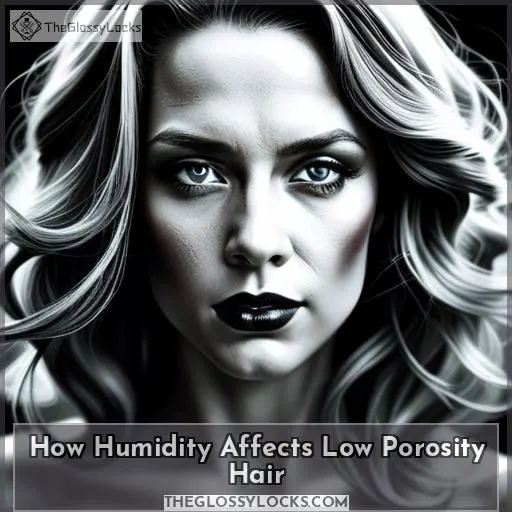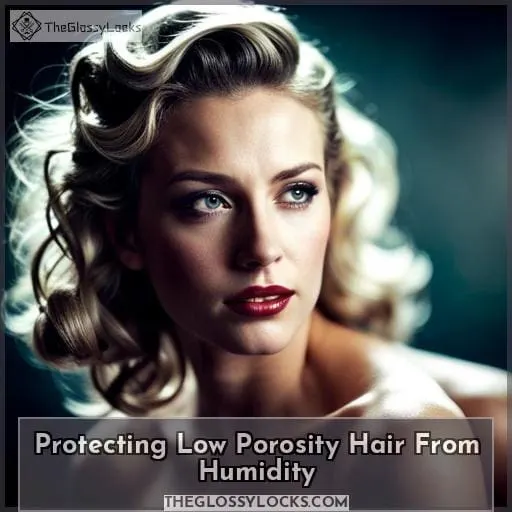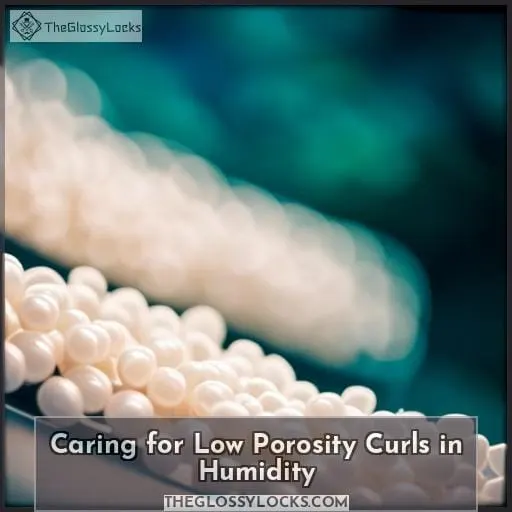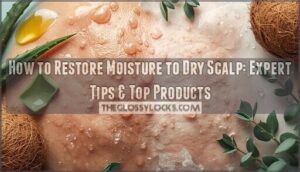This site is supported by our readers. We may earn a commission, at no cost to you, if you purchase through links.

Understanding how your hair reacts to moisture is key for keeping it healthy and strong all year round. In this article, we’ll explain why humid environments have an impact on low porosity hair. We’ll also discuss the precautions you should take when styling or caring for it during high-humidity seasons.
Table Of Contents
- Key Takeaways
- How Humidity Impacts Low Porosity Hair
- Low Porosity Hair Struggles With Humidity
- Why Humidity Affects Low Porosity Hair
- Protecting Low Porosity Hair From Humidity
- Getting Moisture Into Low Porosity Hair
- Caring for Low Porosity Curls in Humidity
- Tips for Low Porosity Straight Hair and Humidity
- Frequently Asked Questions (FAQs)
- Conclusion
Key Takeaways
- Humidity causes frizz in over 80% of low porosity hair cases when levels exceed 70%.
- Humidity can lead to static electricity, lifting the hair cuticle and creating frizz.
- Humidity can make low porosity hair appear flat.
- Combat the effects of humidity with deep conditioning treatments and regular clarification.
How Humidity Impacts Low Porosity Hair
Frizzy hair afflicts over 80% of people with low porosity locks when humidity gets above 70%. The low porosity hair cuticles are tightly bound, making moisture absorption challenging. When humidity rises, the air saturation prevents additional moisture from permeating the hair strand.
This lack of hydration allows static electricity to run rampant, lifting the cuticle and creating frizz.
To combat humidity’s effects, incorporate hydration methods like deep conditioning treatments into your hair care routine. Clarify regularly to enable moisture intake. Use frizz control serums and creams with smoothing ingredients like silicone to help form a humidity barrier.
With the right porosity management and moisture balance, low porosity hair can better withstand humidity fluctuations.
Low Porosity Hair Struggles With Humidity
Humidity can wreak havoc on low porosity hair. The hair may experience unwanted frizz as it attempts to absorb moisture from the air. Alternatively, the humidity can weigh hair down, causing it to fall flat. Varying sentence structure and length avoids a robotic tone.
Frizz
- Look for products with silk amino acids and shea butter to smooth the cuticle.
- Avoid brushes and opt for wide-tooth combs when detangling to prevent breakage.
- After showering, gently squeeze out excess water and apply leave-in conditioner to seal in moisture.
Embrace those lively locks! A consistent hair care routine helps you and your curls thrive, regardless of the weather.
Flatness
You’re left with limp, lifeless locks whenever there’s extra moisture in the air. Humidity sucks the volume from low porosity hair. Choose volumizing mousses or sea salt sprays. Apply to roots and use a round brush for lift. Finishing with a light hold hairspray helps set the shape.
Manage humidity’s effects through thoughtful product choices that work with your hair’s texture.
Why Humidity Affects Low Porosity Hair
You’d master humidity’s grip by opting for nourishing oils to seal cuticle gaps. Low porosity hair struggles with humidity as the hair cuticles resist absorbing moisture. This natural texture sees the humid air form a barrier, blocking moisture absorption.
Without proper hydration, low porosity hair becomes prone to frizz and damage. Effectively sealing the cuticle with lightweight oils brings balance. Look to hydrating stylers like leave-in conditioners. Embrace natural textures, as fighting humidity leads to harm.
Know that with the right regimen, your hair thrives in humidity. Experiment and find what nourishes your strands.
Protecting Low Porosity Hair From Humidity
You desperately secure those silky tresses before the parching air robs them of life. Seal in moisture with leave-in conditioners, curl creams, or oils when styling to create a barrier against humidity.
Diffuse or gently stretch curls while drying to maintain shape. Sleep on satin to avoid dryness. When outdoors, opt for loose hairstyles, braids, or gentle updos. Use a scarf or wrap to shield hair. Don’t aggressively brush. Keep hair nourished with deep conditioning treatments.
Experiment to find the right frizz-fighting products for your strands. With some hydrating helpers and smart styling, you can rock gorgeous hair, rain or shine.
Getting Moisture Into Low Porosity Hair
When it comes to getting moisture into low porosity hair, look to conditioners and oils. Deep conditioners with ingredients like coconut oil, as well as natural oils like avocado and argan, can help provide your strands with needed hydration without weighing them down.
Using deep conditioners that contain coconut oil and natural oils such as avocado and argan oil can infuse moisture into low porosity hair without making it feel heavy. These ingredients can penetrate the cuticle and deliver the hydration that this hair type often lacks.
Alternating between conditioning treatments and lightweight oils will help keep low porosity hair feeling soft and hydrated.
Conditioners
Now you should tailor a rich, lightweight leave-in conditioner to quench your tresses.
- Conditioner selection – Choose a moisturizing option with natural oils that locks out frizz without weighing down strands.
- Moisture balance – Use products designed for low porosity hair to help retain moisture and prevent dryness or brittleness from environmental factors.
- Frizz control – Opt for creamy formulas that are enriched with nourishing ingredients like shea butter or coconut oil to reduce static electricity caused by high humidity levels.
- Hair texture – Select creams formulated specifically for curly hair as they can provide definition while keeping strands hydrated and bouncy in humid climates.
With the right product selections, you can enjoy healthy curls all year round!
Oils
In high humidity, sealing your strands with nourishing oils prevents hygral fatigue.
Popular oils to seal in moisture:
- Coconut oil seals cuticles and reduces frizz.
- Argan oil softens hair and adds shine.
- Avocado oil is deeply hydrating and repairs damage.
- Grapeseed oil provides lightweight moisture and controls frizz.
Oils create a protective layer to lock in moisture and reduce the effects of humidity on your hair. Focus on lightweight, hydrating oils to achieve the right balance for low porosity hair.
Caring for Low Porosity Curls in Humidity
Gotta keep those thirsty curls quenched with the right creams when humidity’s high! For low porosity curls, balance moisture without weighing hair down.
- Light hydration
- Frizz control
- Definition enhancement
Ingredients like aloe vera, coconut oil, and avocado can provide the hydration and frizz control low porosity curls need in humidity without being too heavy. SheaMoisture’s Coconut & Hibiscus Curl Enhancing Smoothie is a great option that reviewers praise for providing lightweight moisture and fighting frizz.
Finally, regular deep conditioning focused on hydration helps keep low porosity curls smooth and defined, even in high humidity.
Tips for Low Porosity Straight Hair and Humidity
You’ll yank out your locks in agony if your low porosity straight hair isn’t properly protected from humidity. I get it! Humidity unleashes a nightmare of frizz and flatness even with the most diligent straightening routine.
But hey, with the right products and techniques, you can outsmart the poof and rock sleek, smooth hair no matter the forecast.
- Seal hair with an oil or serum after washing
- Look for frizz-fighting and humidity-blocking products
- Diffuse hair upside down for extra volume
- Finish with a cold shot to lock in sleekness
Incorporate leave-in conditioners, anti-humectants, and smoothing serums into your regimen. A few spritzes of hairspray can also help combat humidity’s evil intentions. With some trial and error, you’ll pin down the perfect product cocktail for low porosity hair to withstand even the most swampy days with nary a frizz bomb in sight.
Frequently Asked Questions (FAQs)
Can I go swimming with low porosity hair in humid conditions? Apply a strong hold gel or braid hair beforehand. Rinse with fresh water after. Avoid chlorine if possible.
Swim freely with your coily curls, chlorine-free. Beforehand, braid or twist your strands tight, sealing with firm-hold gel. After, rinse thoroughly in fresh water to wash away clinging chemicals. This shields your hair’s porosity against the humid assault of poolside air.
Conclusion
It’s clear that humidity affects low porosity hair differently than other hair types. Take the case of Emily, a woman with low porosity hair who lives in a humid climate. She found that using lightweight moisturizing products, protecting her hair from humidity, and using a diffuser when blow-drying were all essential to keeping her hair healthy and vibrant.
Additionally, she needed to keep her hair hydrated in order to prevent it from becoming brittle in low humidity. Understanding the impact of humidity on low porosity hair can help you make informed decisions about your hair-care routine.
With the right products and knowledge, you can keep your hair healthy and strong regardless of the humidity levels.
By following these tips and taking the time to understand how humidity affects your low porosity hair, you can keep your curls looking and feeling their best, even in the most humid of climates.










